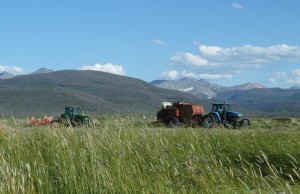Hay has taken over my life. I dream about it, measure it, price it, evaluate it, spit its tobacco-y dust out of my mouth and pick errant shreds of it out of my hair.  I’ve rattled and bounced through our hay meadows on a tractor pulling a rake or a baler, watched hawks eyeing the freshly revealed crop of meadow mice from under those bales, seen the late-day sun turn newly baled fields to gold. I can name the grasses that make up our mountain meadow bales and persuade strangers to pay more for it, because it’s better than anyone else’s.
I’ve rattled and bounced through our hay meadows on a tractor pulling a rake or a baler, watched hawks eyeing the freshly revealed crop of meadow mice from under those bales, seen the late-day sun turn newly baled fields to gold. I can name the grasses that make up our mountain meadow bales and persuade strangers to pay more for it, because it’s better than anyone else’s.
I’m thrilled to pieces to be able to explain what I know about hay to others. Backyard horse proprietors, who previously only knew that they wanted their hay to be green, now are walking, talking fountains of hay wisdom, thanks to me. It’s gratifying.
To work with hay haulers, I’ve memorized hay hauling lingo, so I can converse with the drivers in a manner that’ll put them at ease. I figure if we’re using the same terms, they’ll be more inclined to work for me. This is important, because there’s high demand for their services. All the hay in our county is harvested within the same six-week period. And every rancher wants to get their hay away to customers before the snow comes. The haulers can pick and choose for whom they’ll drive. The best ones have unspoken contracts to haul for certain ranches and if I want them to haul for me it’s like the line at the deli counter: take a number and wait your turn.
In my mission to jump the cue, I’m a fountain of arcane data, able to chat about the total length of a typical hay hauling tractor trailer rig, highway height and weight limits, how wide an entry they need in order to turn into someone’s barn yard, and how much I should pay for our hay to be hauled just about anywhere in the lower forty-eight. I know a “tractor” is the engine and cab part of the big rig, and a “cab-over” is a tractor without a snout. There’s no place to sleep in a cab-over, so anyone who drives one figures his drive will be short enough that he can get home to his own, stationary, bed.
A hay hauling trailer has a “head rack” against which the bales of hay are squeezed to pack them into a secure, safely transportable load. A driver whose trailer doesn’t have one is a driver unaccustomed to the work of loading six hundred hay bales by hand and then delivering it all in one piece to someone 150 miles away. And that could mean trouble. I look for trailers with a conveyor belt built into the bed, which mechanically transfers the entire stack of hay down ramps onto the ground on delivery. Clients love them. And anything my clients love makes me happy.
The time comes in every hay lady’s life, when if you’re gonna talk the talk, you have to walk the walk. It’s one thing to know without a shadow of a doubt that our bales average seventy pounds. It’s quite another to fling all that dry grass around personally. One day I set myself the task of doing the hay equivalent of summiting Everest. I’m going to help load a hay truck.
For weeks I’ve watched drivers with a gut big enough to obscure their belt buckle, strap on stiff leather hay chaps, grab hay grapples that would make Captain Hook green with envy, and load their trucks from our hay stacks. “How hard can this be?” I ask myself. “These guys spend their whole day sitting and driving, and they can do it.” Yes, I come from a life where I’ve been adept not just at accomplishing whatever I set out to do, but doing it better than most. And yes, I’ve now spent months outdoors and active. Still, one side of me tentatively raises its hand, wishing to point out that fitness is relative. It respectfully wishes to remind me that every time I heft a bale and bump it up to my pickup bed with my knee, I heave a secret sigh of relief that I only have to lift one. Now I’m offering to lift three hundred, a disconnect between wishful thinking and reality that is startling in its optimism, disturbing in its naivete.
 Jim, today’s hauler, is waiting in the stack yard when we arrive to start loading. As I toss my hay hooks onto the bed and clamber up he looks at me with surprise. “What you know, girl?” he offers, to cover what I imagine is both his pleasure at having some loading assistance and his dismay that the helper for today is me. Having sent the doubt-monger to sit in the corner, I am impressed with what I’m about to do, giddy that I’m going to join the fraternity of true hay acolytes.
Jim, today’s hauler, is waiting in the stack yard when we arrive to start loading. As I toss my hay hooks onto the bed and clamber up he looks at me with surprise. “What you know, girl?” he offers, to cover what I imagine is both his pleasure at having some loading assistance and his dismay that the helper for today is me. Having sent the doubt-monger to sit in the corner, I am impressed with what I’m about to do, giddy that I’m going to join the fraternity of true hay acolytes.
Bernard plunges the tractor grapple down, and hooks fifteen bales at once, which he swings over and carefully sets down on the bare trailer bed. As work arenas go, the bed of a trailer is a far cry from my former office. Although long, it’s only eight feet wide, which means I’m doing a hay cha-cha-cha on the equivalent of an executive’s desk. Instead of files, this particular desktop now is littered with a jumble of hay bales, which we have to straighten and place in a precise pattern if we’re to fit the maximum number of bales into this load.
Stems of dried grass litter the surface, making it as slippery as soap film on a shower floor. I am so aware of all the tragedies that could befall me in this small space that I hardly dare move. Before even arriving on the trailer bed, any of the bales could loosen from the tractor grapple and hit me, changing the connection between my head and my neck forever. A chance misstep as I maneuver over the cluttered bales, and my newly repaired ACL is history. Bumping into Jim could send me flailing off the trailer for a long unhappy fall to the ground, breath gone, back cracked. One hay hook losing its purchase on a bale would mean an instant rotater cuff tear as that bale’s full weight wrenches my shoulder out of its socket. And the damage inflicted if a hay hook finds a purchase in my thigh instead of a bale doesn’t bear dwelling on.










